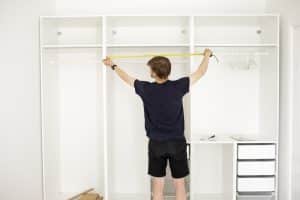
61 Locations Nationwide (800) 838-7995
We're here to help. (800) 838-7995
Schedule a Free Consult
Schedule Your
Free Design Consultation
Free Design Consultation
If you’re looking for a way to upgrade your closet at home, you’ve likely seen DIY closet options online or in big box stores in your area. If you haven’t seen them before or want to know a bit more about what you can expect, read on! After we talk about DIY options, we’ll talk about semi-custom options before moving on to custom options in part 2.
A DIY closet is a system that you purchase in a box from a retailer like Lowe’s or Home Depot. They are usually metal or pressboard to be as sturdy as possible while still being light enough to be sold off the shelf. These DIY closets usually have elements of customizability, giving you the option to move hanging or shelves around, but always within the confines of the system.
 These systems are usually akin to wire or melamine shelving units you’ve seen with adjustability being inherent but not necessarily easy. DIY systems either float or stand on the floor and are secured to the back or side walls, or both. These types of systems are best for people with limited wardrobes, space, and budgets. You’re unlikely to find your ideal closet in a DIY box, but they will get the job done.
These systems are usually akin to wire or melamine shelving units you’ve seen with adjustability being inherent but not necessarily easy. DIY systems either float or stand on the floor and are secured to the back or side walls, or both. These types of systems are best for people with limited wardrobes, space, and budgets. You’re unlikely to find your ideal closet in a DIY box, but they will get the job done.
While the dollar cost of a DIY closet is relatively low, the real cost of a DIY closet is in time, effort, and customizability. DIY systems range from $200+ to more than $1000, with the low-end representing semi-permanent solutions which won’t last the test of time, and the high end representing systems with movable elements and the ability to last for a long time with proper care.
These systems don’t stand up out of the box; in fact, some require substantial time and effort commitments and may require you to purchase tools for the job. As part of the installation process of a DIY closet, you’ll need to remove the existing system. This process should give you an idea of how you’ll need to install your DIY system. Make sure to plan out your installation process before you start! You’ll need to level the system before anchoring it to the walls, and you’ll need to know where drawers and doors need to be to open freely. As you can probably tell, installation of a DIY system is best done by someone who knows their way around a drill.
 Quality of materials, including quality and durability of finishes, are lower in DIY systems. Even fundamental structural components like melamine or steel are of lower quality. And while these systems often offer a few options for placement of modules or the ability to swap options in and out, two things remain true: The options offered by a DIY system will always be one size fits most, requiring you to compromise your design in order to fit in the existing catalog, and; you won’t have the advise of a designer to help you create a closet that will be functional in your space over the long-term. DIY systems require you to calculate clearances for doors and drawers and to account for variables you might not even know to look out for. Expert advice, like the kind provided by our next two options, will streamline and improve your closet experience immensely.
Quality of materials, including quality and durability of finishes, are lower in DIY systems. Even fundamental structural components like melamine or steel are of lower quality. And while these systems often offer a few options for placement of modules or the ability to swap options in and out, two things remain true: The options offered by a DIY system will always be one size fits most, requiring you to compromise your design in order to fit in the existing catalog, and; you won’t have the advise of a designer to help you create a closet that will be functional in your space over the long-term. DIY systems require you to calculate clearances for doors and drawers and to account for variables you might not even know to look out for. Expert advice, like the kind provided by our next two options, will streamline and improve your closet experience immensely.
There are a range of semi-custom DIY options available which bridge the gap between DIY kits and fully custom closets. Some companies offer custom cutting to a design you provide them, allowing you to get a custom space without the cost of full service. These closets will require you to spend substantial time and effort to install but come with the benefit of designer assistance. While you will have to create your own design and won’t necessarily have your own designer, being able to speak with one about your design can be a huge help. Think of these as custom DIY kits rather than truly custom closets, as there will always be limits on how custom your design can be.
 In their role as custom DIY kits, remember the installation process we discussed above. All of those details apply to semi-custom, and builds tend to be more involved. Most handymen will be able to handle the installation process, but we recommend against going with DIY or semi-custom if you don’t have the skills or tools to install the system yourself.
In their role as custom DIY kits, remember the installation process we discussed above. All of those details apply to semi-custom, and builds tend to be more involved. Most handymen will be able to handle the installation process, but we recommend against going with DIY or semi-custom if you don’t have the skills or tools to install the system yourself.
Because these systems are custom, they tend to cost more than off the shelf DIY, and materials tend to be higher quality. A semi-custom walk-in will cost you a bit more than a roughly equivalent off the shelf DIY, which is why these systems occupy the middle price range. For those looking for a bit more customization, nicer materials, and a look they’ll definitely like, semi-custom is the way to go. Once the price starts creeping up a bit higher, you’ll find that it’s going to be better over all to choose a truly custom closet company.
In Part 2 we’ll cover custom closets and talk about what makes a custom system preferable to a DIY system.
Each of our custom systems is completely personalized and begins with a complimentary design appointment.
Schedule a ConsultDuring the consultation you and a designer will discuss goals, desires, and project budget, with the aim of designing an organization system that will: